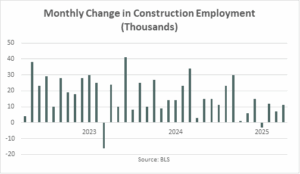by Arsene Aka, Senior Economist at Dodge Construction Network
Employment in the construction industry has weakened this year, which is not surprising given strong economic headwinds. The latest report of the Bureau of Labor Statistics (BLS) shows that construction employment picked up from 7,000 new jobs in March to 11,000 in April. However, the average monthly gain in employment stood at only 7,000 in the first four months of this year, significantly lower than the average gain of 16,000 recorded in 2024.
Both residential and nonresidential specialty trade contractors, as well as nonresidential building construction sectors, saw employment gains last month. Meanwhile, residential building construction sectors and heavy and civil engineering construction recorded a monthly decline in employment. The construction unemployment rate rose to 5.6% last month and is higher than the rate of 5.2% posted a year ago. Finally, year-over-year wage growth in the construction sector decelerated to 3.6% in April, from 3.9% in the prior month. Of note, compensation costs for construction workers (published by the BLS on April 30) also point to a moderating labor market, rising 2.9% year-over-year in the first quarter.
At the national level, the U.S. labor market remained in decent shape, handily beating expectations by adding 177,000 new jobs in April, higher than average monthly gain of 168,000 posted in 2024. The unemployment rate held steady at 4.2%, reflecting an increase in both the number of employed and unemployed individuals. On the other hand, the average hourly earnings for all U.S. employees on private nonfarm payrolls rose 3.8% from April 2023.
Because of the new administration’s trade, deportation and DOGE policies, Dodge Construction Network now expects the Federal Reserve will reduce the policy interest rate three times this year, with the cuts taking place in the second half of this year. Such a monetary policy outlook will provide some support to construction employment and starts this year.

